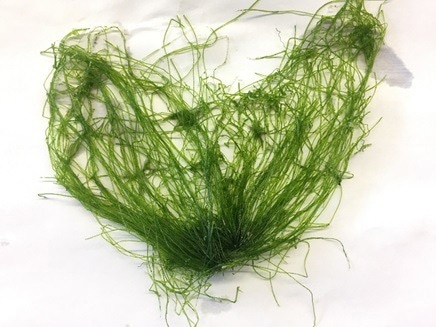We at Gujarat Energy Research and Management Institute (GERMI), made thinnest, light weight, biodegradable, fastest fully charging (within 10 seconds), high tensile strength and performance as well as cost effective paper based supercapacitor which was made from seaweed (marine macroalgae). Recently, this work also been published in peer reviewed journal BioNanoSciecne (a springer publication) and successfully patented. A supercapacitor is an electrochemical charge storage device which have fast charging/discharging cycle, high power density and longer lifecycle. It can be used electronic, memory back-up system, air-bags, heavy machines, electric vehicles etc. so it will become a huge market in this decades.
 Chaetomorpha antennia seaweed. Image Credit: GERMI
Chaetomorpha antennia seaweed. Image Credit: GERMI
The leading scientist Dr. Priyank Bhutiya and Dr. Syed Zaheer Hassan who are marine biopolymer scientist who had extracted cellulose nanofibers from seaweed and rGO-ZnO nanowire were grown over seaweed cellulose nanofibers to get anodic paper supercapacitor. Green seaweed Cheatomorpha antennia was collected from Porbandar, Gujarat area. The process of making paper supercapacitor was very simple and hand made. It should be used as anode material in device. Dr. Brijesh Tripathi from PDEU had tested this device till 6000 cycle for performance and observed same performance at all cycles without any degradation. The energy density of this device was 9.5 Wh/Kg as well as series resistance was 120 Ω. This paper based supercapacitor device was tested in various analytical techniques. Dr. Abdul Rasheed, Dr. P.L.S. Rao and Rahul Kapadiya from GERMI who had co-othered also involved in this research.
This study finds that the marine cellulose based anode material helps in the development of the thinnest paper supercapacitor used in almost all smart electronic devices and also generate economy for coastal communities for seaweed cultivation to manufacturing of paper supercapacitor from seaweed.
Please find link for research paper published in a peer reviewed journal BioNanoScience (Springer Publications) https://link.springer.com/article/10.1007/s12668-023-01101-5